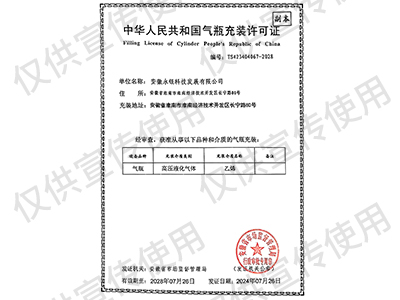Organic gas
![]()
1-Butylene (also known as n-butene) as the main basisChemical Products, the application fields are relatively wide. With the development of downstream LLDPE and HDPE markets, the demand for 1-butene application continues to rise, and the industry field has developed rapidly. In terms of production, the main raw material of 1-butene is C4. In recent years, with the development of the chemical industry market, most petrochemical enterprises have equipped C4 processing devices, so the actual market circulation of 1-butene is relatively small and does not fully meet downstream demand. Therefore, the import volume of 1-butene in my country has shown a growth trend.
1. Alias·English name
α- 丁烯; alpha-beautylene 、 1-bounce。
2. Use
Organic synthesis intermediates, detergents,Synthetic gasoline, plastics and synthetic rubber.
3. Method of making
1. The heat of oilCatalytic cracking。
2. Fractionation of natural gas.
3. Catalytic hydrogen removal of butane.
4. Polymerization of ethylene.
4. Physical and chemical properties
|
Molecular weight |
56.108 |
|
Three-phase dots |
-185.4℃ |
|
Boiling point (101.325kPa) |
-6.3℃ |
|
Liquid density (-6.3℃, 100kPa) |
630kg/m3 |
|
Gas density (101.325kPa, 25℃) |
2.365kg/m3 |
|
Relative density (101.325kPa, 25℃, air = 1) |
2 |
|
Specific volume (21.1℃, 101.325kPa) |
0.4182m3/kg |
|
Gas-liquid volume ratio (15℃, 100kPa) |
261L/L |
|
Critical temperature |
146.4℃ |
|
Critical pressure |
4023kPa |
|
Critical density |
233kg/m3 |
|
Heat of melting (-185.4℃) |
68.589kJ/kg |
|
Heat of gasification △Hv (-6.26℃) |
413.3kJ/kg |
|
Specific heat capacity (gas, 101.325kPa, 25℃) |
Cp=1.5564kJ/(kg·K) |
|
Specific heat ratio |
Cp/Cv=1.104 |
|
Viscosity (gas, 101.325kPa, 20C) |
0.00763mPa·S |
|
(Liquid, -40℃) |
0.272mPa·s |
|
Vapor pressure (-60℃) |
6.65kPa |
|
(0℃) |
128.04 |
|
(40℃) |
457.4kPa |
|
Surface tension (O℃) |
15.6mN/m |
|
Thermal conductivity coefficient (gas, 101.325kPa, 25℃) |
0.01444W/(m·K) |
|
(Liquid, -40℃) |
0.1456W/(m·K) |
|
Refractive index nD (liquid, -25℃) |
1.3777 |
|
Ignition point (100kPa) |
385℃ |
|
Combustion limit in the air (20℃, 100kPa) |
1.6%~10% |
|
Equivalent combustion flame temperature |
2035℃ |
|
The maximum velocity of the burning flame is equivalent to |
0.43m/s |
|
Flammability level |
4 |
|
Toxicity level |
1 |
|
Reactive activity level |
0 |
1-Butylene is colorless at room temperature and pressureCombustible gases. Easily soluble in alcohol andEthyl, insoluble in water. It is easy to vaporize into liquefied petroleum gas and is charged in low-pressure cylinders, and S.P is at 21.1℃. It is 263.4kPa.
V. Toxicity
1-Butylene has an anesthetic effect at high concentrations, and its anesthetic effect is 4.5 times that of ethylene. The skin contact with the liquid 1-butene can cause frostbite.
After inhalation, shortness of breath and dullness may occur.Muscle disorders, symptoms such as wrong judgment, rapid fatigue, nausea, vomiting, etc.
6. Safety protection
The main risk factor for treating 1-butene is its flammability. Never use fire to detect leaks, use soapy water. Steel cylinders should be stored in a well-ventilated place, away from heat sources and fire, and should not be stored with oxygen, chlorine, strong oxidants or combustible materials; pipelines and equipment should be grounded.
1-Butylene is a non-corrosive gas and can be used in general metals. Polytetrafluoroethylene andPolychlorotrifluoroethylene。
Carbon dioxide, dry powder and mist water can be used to extinguish fires.
- Previous:Propylene
- Next:Isobutylene





